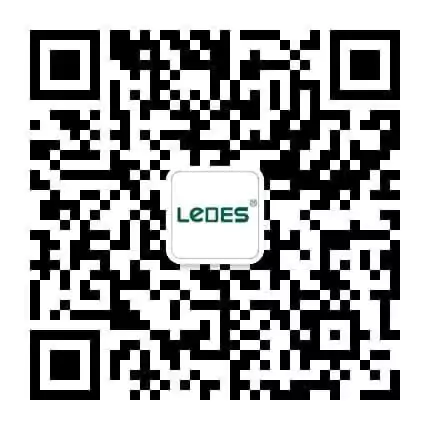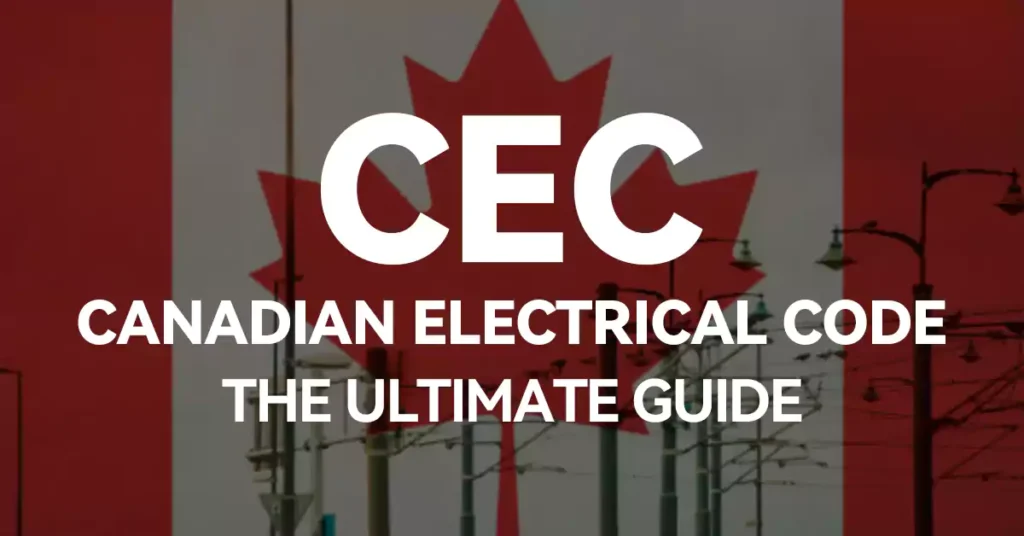
目录
电气安全是现代基础设施的基石,确保住宅、企业和工业免受危害。每年,电气故障导致加拿大各地发生超过1400起火灾,造成1400多亿加元的财产损失。这些令人担忧的数字凸显了严格安全法规的重要性——而加拿大电气规范 (CEC) 正是这项工作的先锋。
CEC 不仅仅是一份监管文件,更是一份不断发展的标准,它会随着技术进步、安全创新和新兴风险的出现而不断发展。从住宅项目的布线方法到工业设施的电气安装,CEC 都是安全、合规、可靠的电气系统的基础。
本指南为何重要
对于电气行业的专业人士来说,理解 CEC 规范可能非常复杂。该规范反映了电气技术、可再生能源整合以及安全标准的提升。及时了解这些更新对于以下方面至关重要:
- 确保遵守法律和安全要求
• 避免代价高昂的错误和项目延误
• 提高电气系统的安全性
• 提高电气设计和安装效率
本终极指南旨在分解 CEC 的关键方面,使其更易于理解和应用。无论您是经验丰富的电工还是电气安装新手,本指南都能清晰地讲解 CEC 的结构、要求以及在实际场景中的应用。
什么是加拿大电气规范 (CEC)?
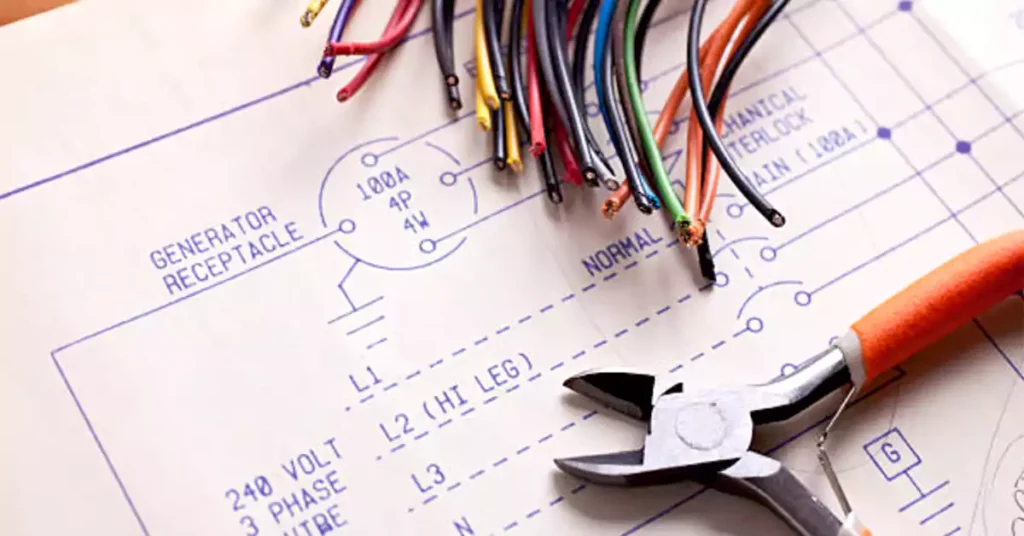
加拿大电气规范 (CEC),也称为 CE 规范或 CSA C22.1,是由加拿大标准协会 (CSA 集团) 发布的一项国家标准。该规范规范加拿大各地电气设备的安装和维护,确保安全、高效并符合现代电气规范。
加拿大电气委员会 (CEC) 是加拿大电线法规的基础,它提供了一个规范性的模型,详细列出了可接受的电线布线方法。虽然该规范允许采用其他安全安装方法,但这些方法必须获得当地执法机构的批准。
CEC 的历史与演变
近一个世纪以来,加拿大电气规范 (CEC) 一直是加拿大电气安全框架的重要组成部分。CEC 于 1927加拿大电气委员会(CEC)的成立旨在在全国范围内建立统一的电气安全标准。几十年来,随着电气技术的进步,CEC 也不断发展,不断适应新的挑战、创新和监管要求。
加拿大标准协会(CSA集团)是一家独立的非营利组织,负责开发和维护CEC。CSA更新了代码 每三年,确保它反映新出现的安全问题、电气工程的进步以及不断发展的行业需求。
几十年来,每个版本都为更安全的安装和降低与电气工作相关的风险做出了贡献。
- 1927: CEC 第一版发布,为安全电气实践奠定了基础。
- 20世纪中期: 我们进行了多次修改,以融入不断发展的技术和更好的实践。
- 2024: 最新版本——第 26 版,发布于 2024,包括反映最新电气安全技术和实践的重要更新,包括接线方法的变化和新设备的更新标准。
CEC 的制定是来自行业、政府机构和电气安全组织的志愿者共同努力的结果。几十年来,该规范不断扩展,以应对新的挑战,包括:
- 接地和接合方面的进步 提高电气安全
- 电弧故障和接地故障保护 减轻电气火灾危险
- 能源效率要求 用于现代电气系统
- 可再生能源整合指南包括太阳能和电动汽车(EV)充电基础设施
该规范不断发展,以适应日益复杂的电力系统和可持续能源解决方案。
管理机构:谁来监管 CEC?
虽然 CSA 集团负责发布和维护 CEC,但加拿大各省和地区都独立采用和执行该准则,并且通常会对特定地区进行修订。
省和地区收养
电气安全由省级和地区级机构监管。部分地区可能:
- 立即实施最新的 CEC 版本。
- 根据当地需求引入行政或技术修正案。
- 根据略微修改后的 CEC 版本进行操作,以符合特定省份的要求。
例如:
- 魁北克遵循《魁北克建筑规范》第五章 – 电力,该规范与 CEC 非常相似,但包括省级修改。
- 安大略省和不列颠哥伦比亚省可能会采取额外的防火和安全措施。
符合国家建筑规范
加拿大电气委员会 (CEC) 与加拿大国家建筑规范 (NBC) 协同工作。NBC 涵盖结构、防火和能源效率要求,而 CEC 则确保所有电气装置符合严格的安全和性能标准。这种协同有助于构建一个统一的国家电气和建筑安全框架。
对行业安全的影响
CEC 在减少加拿大各地的电气危害方面发挥了至关重要的作用,具体如下:
- 标准化布线和接地实践以防止故障。
- 需要先进的保护机制(例如电弧故障和接地故障断路器)。
- 加强电气设备监管,确保安全性和耐用性。
- 解决电动汽车充电站和可再生能源等新兴技术。
通过严格遵守 CEC,电工、承包商和工程师为世界上最安全的电力基础设施之一做出了贡献。
每位专业人士都必须了解的 CEC 关键部分
CEC 零件概述
加拿大电气规范 (CEC) 分为多个部分,以满足电气安装的各种要求。其中某些章节与电线和导管应用特别相关。
第一部分:电气装置安全标准
本节规定了电气设备安全安装、操作和维护的基本准则。它包括对接线方法、接地、过流保护和安全协议的全面要求,以确保符合国家电气安全标准。
第二部分和第三部分:产品特定标准和专用设备指南
这些部分涵盖电气产品和专业安装的详细技术规格。它们为电气标志、工业机械和危险区域布线等特定应用提供指导,确保产品符合安全和性能标准。
CSA C22.1:24 的关键章节
CEC 中的几个部分专门关注住宅、商业和工业应用的电线、导管和安装实践:
第 12 节:布线方法和线槽
本节提供了不同类型的导管和线槽的详细要求,包括:
- 导管安装 – 不同类型的安装场景,如地下安装、静压箱布线、架空地板下布线等。(注:了解更多关于 电气导管安装技巧 (这是我们最后一篇文章)
- 线路槽 – 指定线路槽,包括根据环境条件使用 PVC、金属和防水导管。以及用于支撑线路的电缆桥架。
第 18-24 节:商业和工业布线
这些部分概述了具有挑战性的环境的关键安装要求,包括:
- 危险场所(第 18 节) – 爆炸性环境分类和防止点火的导管密封要求。
- 汽油分配和服务站(第 20 节) – 燃料处理区域的布线方法,强调耐腐蚀导管材料。
- 工业设施(第22节) – 在有腐蚀性液体、蒸汽和过多水分的区域安装电气装置。
- 病人护理区(第 24 节) – 医院和医疗机构电气系统的特殊接地和隔离要求。
第 64 节:可再生能源系统
随着可再生能源应用的增长,本节提供了以下方面的基本指导:
- 太阳能光伏(PV)装置 – 屋顶和地面安装太阳能电池板的布线和导管要求。
- 风能系统 – 风力涡轮机装置中电线管道的安全布线。
- 电池存储系统 – 将能源存储解决方案与电力基础设施相结合的合规标准。
这些章节确保电气专业人员在安装安全、可靠且符合规范的电线和导管系统时遵守 CEC 标准。在以下章节中,我们将详细探讨每个主题。
深入了解 CEC 代码的关键部分
CEC 规范规定了与电气相关的所有方面的要求,这里我们将仅介绍一些与电线、管道槽和安装相关的重要信息。
布线方法和线槽(第 12 节):
加拿大电气规范 (CEC) 第 12 条概述了确保电气安装安全可靠的布线方法的一般要求。这些要求涵盖各种布线系统的选择、安装和支持。
接线方法的一般要求:
导体绝缘:
导体必须具有适合系统电压和安装特定环境条件的绝缘。例如,非接地或阻抗接地系统中使用的导体应符合特定的绝缘厚度要求,以确保安全。
防止机械伤害:
应选择并安装合适的布线方法,以保护导体免受机械损坏。这包括在导体可能暴露于潜在损害的区域使用合适的线槽或导管。
支持和安全:
导体和线槽必须按照规范规定的间隔牢固固定和支撑,以防止下垂、物理损坏或端接处过度拉力。
间距:
在电缆槽中安装导线、导管或电缆时,必须根据相邻导线的尺寸保持适当的间距。这可确保充足的通风并降低过热风险。
地下安装要求
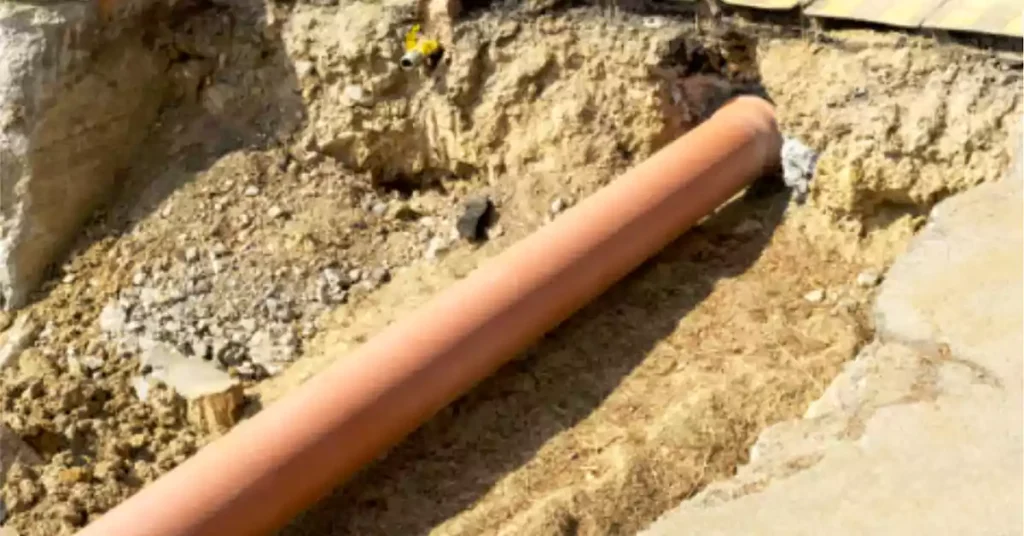
CEC 中介绍了多种布线方法,其中一种是我们经常使用的地下安装。以下是这种安装方法的一些关键要求:
- 最低保险要求:
直埋电缆或管道必须符合 CEC 表 53 中规定的最小覆盖深度。这些深度取决于所采用的布线方法和具体的安装条件等因素。
- 载流量考虑因素:
当导线和电缆从地下设施过渡到地上设施并端接于电气设备时,其载流量必须根据表 1-4 中 75°C 列确定。这确保符合 CEC 的规定。
- 分离要求:
规则 12-012 规定了管道内电缆或导体地下安装的具体间隔要求。该规则确保安装过程中保持足够的间距,以防止潜在危险。
- 地下设施的标记:
所有地下线路装置必须有充分的标记,以指示其存在。常见的做法包括在沟槽内电线上方一半的位置埋设电气警示标记带,或使用永久性地上标记,例如印刷标志。
特定类型导管的要求:
使用和限制: 硬质PVC导管适用于各种安装,例如露天作业、地上和地下作业。但它在CEC中有一些特定的限制,例如必须安装在隔热材料内。
温度限制: PVC 导管不得承受超过 75°C 的温度,以保持其结构完整性。
导体数量: CEC 规则 12-1120 规定了 PVC 导管内允许的最大导体数量,以防止过热并确保安全。
配件和支持: 必须使用合适的配件,以确保安装安全可靠。CEC 还规定了导管支架的最大间距,以保持机械稳定性。
粘合: 指定了接地连续性规定,以确保整个安装过程中的电气安全。
使用和限制: 这些导管类型设计用于地下安装,其中 DB2/ES2 适合直接埋设,EB1 适合埋入混凝土中。
温度限制: CEC 规定了温度限制,以确保这些导管正常运行且不会出现性能下降。
机械保护: 概述了机械保护要求,以保护导管免受物理损坏。导管应具有足够的抗冲击、抗拉伸、抗挤压等机械强度。
安装方法: Rule 12-1162 specified the method of installing these direct burial conduit types, and together with fittings such as couplings, bends, adapters to complete the installation.
高密度聚乙烯 (HDPE) 导管:
使用和限制: HDPE conduit is permitted for specific applications, particularly in underground installations where flexibility and corrosion resistance are advantageous.
温度限制: The CEC outlines temperature limitations for HDPE conduits to ensure they operate safely under various conditions.
安装方法: Specific methods of installation are prescribed in rule 12-1254 to maintain the integrity and safety of HDPE conduit systems.
Electrical Non-metallic Tubing:
Uses: Electrical nonmetallic tubing is permitted in underground when in accordance with Rule 12-012, and in exposed or concealed locations. But should not be used in locations where subjected to damage unless provided with mechanical protection.
温度限制: ENT is designed to withstand specific temperature ranges. Installers must ensure that the ambient temperature does not exceed the tubing’s rated capacity 75°C to maintain its structural integrity and safety.
支持和安全: ENT must be securely supported and fastened at intervals by straps. Additionally, supports should be placed within 1m of every outlet box, junction box, device box, cabinet, or fitting to prevent sagging and maintain alignment. And the spacing between supports should be not more than 1m.
导体数量: The number of conductors installed within ENT must not exceed the fill capacities specified in CEC Rule 12-910. It provides the maximum number of conductors of various sizes that can be safely installed to prevent overheating and ensure ease of installation.
Fittings and Connections: Only fittings specifically designed and listed for use with ENT should be utilized. These fittings ensure proper connections and maintain the integrity of the raceway system. Solvent cement or other approved methods should be used to join fittings, ensuring a secure and continuous pathway for conductors.
Commercial and Industrial Systems (Section 18-24):
Sections 18-24 of the Canadian Electrical Code (CEC), CSA C22.1:21, provide critical guidelines for ensuring the safety and functionality of electrical installations in commercial and industrial environments. These sections cover essential aspects related to hazardous locations, flammable liquid handling, environments with corrosive materials, and patient care areas.
Key information and requirements include:
Hazardous Locations (Section 18):
Classification of Hazardous Locations: Defines Class I (flammable gases or vapors), Class II (combustible dust), and Class III (flammable fibers or flyings) locations.
接线方法: Requires explosion-proof enclosures, sealed conduit systems, and intrinsically safe circuits to prevent ignition.
温度限制: Specifies maximum surface temperatures for electrical equipment to avoid ignition in explosive atmospheres.
Bonding and Grounding: Essential to prevent static discharge and control potential differences.
Flammable Liquid Handling and Storage Facilities (Section 20):
Guidelines for electrical systems in fuel stations, bulk storage plants, service stations, garages, finishing processes, and aircraft hangars.
Service Stations, Garages, Bulk Storage Plants, and Aircraft Hangars: Mandates the use of sealed conduit systems and explosion-proof lighting and devices.
Ventilation and Control Systems: Requires proper ventilation and emergency shut-off systems to prevent fire and explosion hazards.
接地和接合: Ensures proper grounding of tanks, piping, and electrical equipment to prevent static discharge.
Corrosive and Moisture-Prone Environments (Section 22):
Protection of electrical systems in locations exposed to corrosive liquids, vapors, and excessive moisture. This involves using corrosion-resistant materials, sealing systems against moisture ingress, and ensuring proper grounding and bonding.
Material Selection: Requires the use of corrosion-resistant conduits (e.g., PVC rigid conduit, HDPE conduit, and non-metallic tubing) and enclosures.
Sealing and Insulation: Prevents moisture ingress through sealed fittings and junction boxes.
Support and Bonding: Specifies proper conduit support spacing and bonding for electrical continuity and protection against deterioration.
Patient Care Areas (Section 24):
Special requirements for electrical installations in healthcare facilities to ensure the safety of patients and medical equipment.
Isolated Power Systems: Reduces the risk of electric shock by isolating circuits and monitoring ground faults.
Redundant Grounding and Equipment Bonding: Ensures continuous protection for sensitive medical equipment.
Use of Hospital-Grade Devices: Specifies hospital-grade receptacles, wiring methods, and electromagnetic interference protection.
By adhering to these guidelines, commercial and industrial facilities can mitigate the risks associated with hazardous materials, flammable environments, corrosive conditions, and sensitive medical areas. Compliance with these sections is vital for safeguarding personnel, equipment, and infrastructure while meeting regulatory standards and enhancing overall safety.
Renewable Energy Systems (Section 64):
Section 64 of the Canadian Electrical Code (CEC), CSA C22.1:24, establishes the requirements for the safe installation and operation of renewable energy systems, energy production systems, and energy storage systems. This section is essential for ensuring electrical safety, efficiency, and compliance with modern energy technologies.
Key Information and Requirements:
- Renewable Energy Systems:
Solar Photovoltaic (PV) Systems, Wind Turbines, and Hydro Systems: Guidelines for proper wiring methods, grounding, and protection against overcurrent and fault conditions.
Inverter and Power Conditioning Equipment: Requirements for safe integration with utility power and grid-tied systems.
Disconnecting Means and Safety Controls: Ensures the ability to isolate renewable energy sources during maintenance or emergencies.
- Energy Production Systems:
Distributed Generation Systems: Regulations for small-scale power generation and microgrids.
Connection to Utility Grid: Standards for interconnection, metering, and synchronization with the electrical grid.
Protection Against Backfeed and Fault Current: Prevents hazards related to reverse power flow and system instability.
- Energy Storage Systems (ESS):
电池存储系统 (Lithium-ion, Lead-acid, and Flow Batteries): Installation requirements for safe handling, ventilation, and thermal management.
Inverter and Charge Controller Compatibility: Ensures proper charging and discharging control.
Emergency Shutdown and Fire Protection: Provides measures to prevent thermal runaway and ensure safe shutdown in critical situations.
Additional Critical Factors:
- Grounding and Bonding Requirements: Prevents electrical shock and ensures system stability.
- Protection Against Overvoltage and Overcurrent: Safeguards the electrical system and connected equipment.
- Inspection and Maintenance Protocols: Regular inspections and monitoring to ensure long-term performance and compliance.
Compliance with Section 64 is vital for supporting the transition to clean energy while maintaining the safety and reliability of electrical systems.
Compliance & Enforcement Across Canadian Jurisdictions
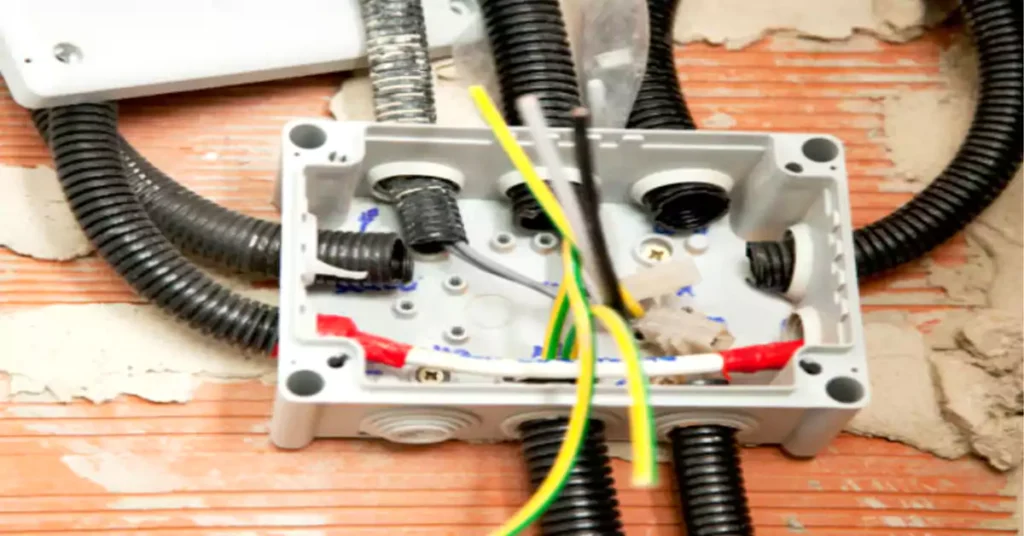
Ensuring electrical safety across Canada relies on the effective adoption and enforcement of the Canadian Electrical Code (CEC). While the CEC provides a national framework, each province and territory tailors its implementation to address local needs and conditions.
A. Provincial & Territorial Adoption
The CEC is a voluntary standard developed by the Canadian Standards Association (CSA), intended for adoption by regulatory authorities. Each province and territory decides how to integrate the CEC into its regulations, often with specific amendments to suit regional requirements.
- Ontario: The Ontario Electrical Safety Code (OESC) incorporates the CEC with modifications to address local safety concerns and environmental conditions.
- Alberta: Alberta Municipal Affairs adopts the CEC and may supplement it with additional regulations to meet the province’s unique industrial and residential needs.
These adaptations ensure that while the CEC provides a common safety baseline, each region can enforce additional measures where necessary.
B. Regulatory Enforcement
Enforcement of the CEC is managed by local inspection authorities and regulatory bodies within each province and territory. Their responsibilities include:
- Inspections: Conducting regular assessments to verify compliance with the Code.
- Permitting: Ensuring that electrical installations have the necessary permits before work begins.
- Amendment Enforcement: Implementing and overseeing local amendments to address regional safety challenges.
Regulatory authorities actively participate in the development of the CEC, with representation on the Canadian Electrical Code, Part I Committee from all provinces and territories, as well as major municipalities like Winnipeg, Calgary, and Vancouver.
C. Adoption Variations
The timing and edition of CEC adoption can vary across jurisdictions. For instance, as of December 2021, Alberta adopted the 2021 edition of the CEC, effective February 1, 2022, while British Columbia’s adoption took effect on October 1, 2022.
D. Expert Insights
Industry experts emphasize that regional adaptations of the CEC are crucial for addressing local challenges. The combination of a robust national standard with regional amendments results in installations that are both safe and tailored to local needs.
案例研究
In Ontario, the integration of the Canadian Electrical Code (CEC) with provincial amendments ensures that electrical installations meet both national and local safety standards. A notable example is the rigorous enforcement of the Ontario Electrical Safety Code (OESC), which incorporates the CEC with specific modifications to address regional conditions.
While specific case studies detailing the implementation of the OESC in multi-residential buildings are not readily available, the Electrical Safety Authority (ESA) emphasizes the importance of proactive maintenance and compliance with updated codes to prevent system failures in aging multi-unit residential buildings.
In summary, while the CEC provides a national framework for electrical safety, its effective implementation relies on provincial and territorial authorities adapting and enforcing the Code to meet local conditions and requirements.
Navigating CEC Compliance: A Step-by-Step Guide
Achieving full compliance with the Canadian Electrical Code (CEC) is not just about following national standards but also understanding the unique requirements of each province and territory. By integrating key CEC sections – such as wiring protection, hazardous locations, fire prevention, and installation standards – electricians and contractors can ensure safe and code-compliant electrical installations. Here’s a practical 4-step guide:
Step 1: Understand Provincial Amendments
Since the CEC serves as a national standard, each province and territory has the flexibility to implement its own amendments to meet local safety and environmental needs. Understanding these regional variations is crucial for compliance:
Ontario: The Electrical Safety Authority (ESA) mandates AFCI (Arc Fault Circuit Interrupter) protection for all bedroom circuits to prevent electrical fires.
Quebec: The Régie du bâtiment du Québec (RBQ) enforces bilingual labeling for electrical panels to ensure safety for both French and English speakers.
British Columbia: Contractors must submit a “Declaration of Compliance” form to Technical Safety BC before final inspections.
Section 12 (Wiring Methods) and Section 26 (Installation of Electrical Equipment) address proper AFCI protection and labeling practices. Following these guidelines not only meets local amendments but also enhances fire prevention and wiring protection.
Step 2: Conduct Risk Assessments and Inspections
A thorough risk assessment helps identify potential code violations before installation. Using modern compliance tools can streamline this process:
- CSA’s “CEC Quick Check” App allows contractors to quickly identify code gaps and potential hazards.
- Evaluating Hazardous Locations: Sections like 18 and 20 of the CEC provide guidelines for installations in areas with explosive gas atmospheres or flammable liquids. Proper classification of these zones is vital to mitigate risks.
- Fire Protection Standards (CEC Section 22): For areas exposed to combustible fibers or dust, selecting the right conduit and equipment prevents overheating and sparks.
- Assessing Wiring Methods: Section 12 outlines acceptable wiring methods, ensuring that installations meet safety standards and are appropriate for the specific environment.
Case Study: A Winnipeg hospital successfully reduced rework costs by 30% by hiring third-party inspectors for pre-approval inspections, identifying non-compliance issues in hazardous areas before final installation.
Step 3: Certify with Local Authorities
Proper documentation and certification are critical to proving compliance with the CEC. Each province has specific requirements:
In British Columbia, contractors must submit the “Declaration of Compliance” form to Technical Safety BC.
In Ontario, securing an ESA inspection report is necessary before energizing any installation.
Section 24 (Patient Care Areas) ensures electrical safety in healthcare facilities, while Section 32 covers installations in emergency systems, such as fire alarms and exit lighting.
Step 4: Leverage Educational Resources and Training
Staying updated with the latest CEC revisions and best practices is essential for long-term compliance:
ESA’s “Code Coach” Webinars provide expert guidance on common compliance mistakes.
CSA’s CEC Handbook offers detailed commentary from code drafters and practical installation tips.
Online Training Portals: Access to training modules and certification programs keeps professionals updated on code changes and best practices.
Expert Tip from an Electrical Engineer:
“A common compliance pitfall is improper cable protection in high-vibration environments or wet locations. By following CEC Section 12 for conduit selection and Section 18 for hazardous location installation, contractors can avoid costly rework and safety risks.”
By following this structured 4-step approach and integrating key CEC sections, electrical professionals can ensure compliance with both national standards and provincial amendments. This not only enhances safety in wiring protection, hazardous environments, and fire prevention but also reduces installation errors and project delays.
2024 CEC Updates: What's New?
The Canadian Electrical Code (CEC) undergoes regular revisions to address emerging technologies, enhance safety protocols, and improve clarity in electrical installations. The 2024 edition introduces several notable changes that professionals in the electrical industry should be aware of.
Renewable and Energy Storage Systems
Lithium Battery Integration: The previous restrictions on lithium battery usage in residential energy storage systems have been lifted, allowing for more flexible and efficient energy solutions.
Photovoltaic Systems: New rapid shutdown requirements have been implemented for photovoltaic installations to enhance firefighter safety during emergencies.
Improved Safety for Pools, Tubs, and Spas
Bonding Requirements: Revisions aim to mitigate voltage gradients around pools and portable hot tubs, reducing the risk of electric shock.
断开方式: Enhanced guidelines have been introduced to improve maintenance safety for these installations.
医疗保健设施
Tamper-Resistant Receptacles: The code now mandates the use of tamper-resistant receptacles in areas designated for child care and diagnostics to enhance patient safety.
Wiring Methods
Non-Metallic Jacketed Cables: A new subsection addresses requirements for non-metallic jacketed cables, such as TC and LVT types, detailing guidelines for their support and bonding.
Overhead Installations: There are updated rules concerning cable supports, bonding conductors, and span limits to ensure structural integrity and safety.
Conductors
AWG and IEC Metric Alignment: A new table aligns American Wire Gauge (AWG) sizes with International Electrotechnical Commission (IEC) metric sizes, simplifying conductor selection.
Voltage Drop Calculations: The methodology for calculating voltage drops has been revised to ensure more accurate conductor sizing, promoting efficiency and safety.
Bonding and Grounding
Simplified Grounding Criteria: The code introduces simplified criteria for grounding alternating current (AC) systems, reintroduces isolated bonding conductors, and clarifies bonding requirements for non-electrical equipment like gas piping.
Electric Vehicles (EVs)
Load Calculations: Clarifications have been made regarding load calculations when using EV energy management systems, facilitating the integration of EV infrastructure.
尖端: If you would like to compare with NEC code for EV charging infrastructure, you can read our last post for NEC Code Compliance for EV Charging.
Case Study: A Toronto Contractor's Experience Adopting 2024 Updates
In Toronto, a local electrical contractor undertook a project to install EV charging stations in a commercial building. By adhering to the 2024 CEC updates, particularly the clarified load calculation methods for EV energy management systems, the contractor optimized the building’s electrical load without necessitating extensive infrastructure upgrades. This approach resulted in cost savings and ensured compliance with the latest safety standards.
The 2024 updates to the Canadian Electrical Code reflect a commitment to safety, efficiency, and adaptability in the face of evolving technologies and industry practices. Professionals should familiarize themselves with these changes to ensure compliance and to promote best practices in all electrical installations.
Common CEC Violations and How to Avoid Them
Compliance with the 2024 Canadian Electrical Code (CEC) is crucial to ensuring the safety, reliability, and efficiency of electrical installations. However, even experienced electricians and contractors can sometimes overlook critical requirements, leading to violations that result in fines, project delays, and even voided insurance policies.
Understanding the most common CEC violations and how to prevent them will not only help avoid unnecessary risks but also improve the overall quality of your electrical projects.
1. Improper Grounding and Bonding
Violation: Failure to properly ground electrical panels, equipment, and metal conduit systems is one of the most frequent code violations, especially in older installations and retrofitting projects.
Why it happens: Often due to the incorrect use of bonding jumpers or missing ground electrodes.
2024 CEC Update Impact: The new code simplifies bonding requirements for non-electrical equipment, such as gas piping, and reintroduces isolated bonding conductors for AC systems.
How to avoid it:
Use CEC-approved grounding conductors and bonding clamps.
Install isolated bonding conductors for AC systems.
Choose PVC rigid conduit or HDPE corrugated conduit to prevent corrosion in high-moisture environments.
2. Overloaded Circuits in Residential Upgrades
Violation: Adding new loads to existing circuits without calculating the updated current demand.
Home renovations, such as adding EV charging stations or HVAC systems, often exceed the original circuit capacity.
CEC Update Impact: New rules for load calculation in EV energy management systems allow electricians to exclude the EV charger load under controlled management systems.
How to avoid it:
Conduct accurate load calculations before upgrades.
Use dedicated circuits for high-load devices like Level 2 EV chargers.
Upgrade to larger gauge conductors based on the new CEC voltage drop calculation method
Use CEC-compliant conduit systems like Schedule 40 PVC or DB2 duct to safely handle additional wiring capacity.
3. Non-Compliant Wiring in Agricultural Facilities
Violation: Improper installation of wiring methods in barns, greenhouses, and grain handling facilities.
Why it happens: Use of standard residential wiring methods in high-moisture or corrosive environments.
CEC Update Impact: Enhanced requirements for non-metallic jacketed cables (such as TC-type cables) and better bonding and support rules for overhead installations.
How to avoid it:
Use corrosion-resistant conduit systems, such as PVC rigid conduit or HDPE corrugated conduit, for agricultural environments.
Ensure proper bonding and grounding in wet locations.
Follow the CEC’s revised voltage drop calculation to size conductors accurately over long distances.
4. Incorrect GFCI Protection in Outdoor and Wet Locations
Violation: Lack of proper Ground Fault Circuit Interrupter (GFCI) protection for outdoor circuits or temporary power setups.
Why it happens: Often overlooked on construction sites and outdoor events like film sets or festivals.
CEC Update Impact: New GFCI protection requirements for portable extension cords and stricter rules for single-conductor cable labeling.
How to avoid it:
Install GFCI outlets or breakers for all outdoor circuits and temporary power systems.
Use CEC-compliant extension cords with built-in GFCI protection.
Follow updated labeling standards for safe cable identification.
Ensure proper conduit protection for temporary power distribution, such as liquid-tight flexible conduit (LFMC).
5. Improper Conduit Installation and Support
Violation: Using incorrect conduit types or failing to secure conduit supports in overhead installations.
Why it happens: Lack of knowledge about the new CEC wiring methods section for conduit systems.
CEC Update Impact: Added rules for support spacing, bonding conductors, and cable span limits.
Improved sealing methods for outdoor installations.
How to avoid it:
Use Schedule 40 PVC conduit for above-ground installations.
Choose DB2 PVC duct for direct burial applications. (Pro Tips: You can read our last post for 6 types and DB duct and buying guide.)
Install Ledes Solar Conduit and Fittings for renewable energy systems.
6. Incorrect Voltage Drop Calculation for Large-Scale Projects
Violation: Undersized conductors due to incorrect voltage drop estimation in long-distance wiring.
Why it happens: Traditional voltage drop formulas often lead to miscalculations.
CEC Update Impact: New voltage drop calculation table with AWG and IEC metric sizes.
Improved conductor sizing methodology for accurate long-distance runs.
How to avoid it:
Use larger gauge conductors based on the new table.
Install conduit with high thermal resistance
Select high-performance conductors, such as copper-clad aluminum or HDPE conduit systems for long-distance runs.
7. Failure to Meet New Fire Safety Standards
Violation: Using non-fire-rated conduit and junction boxes in high-rise residential and commercial buildings.
CEC Update Impact: New fire-resistant conduit system requirements for multi-unit dwellings.
Mandates Low Smoke Halogen-Free (LSZH) conduit and fittings for emergency circuits.
How to Avoid It:
Install LSZH conduit and fittings for fire protection.
Use low-voltage conduit solutions that meet UL94 V-0 and 5VA flammability ratings.
Follow the CEC’s revised installation methods for fire-rated walls and ceilings.
CEC vs. NEC: Key Differences for Cross-Border Projects
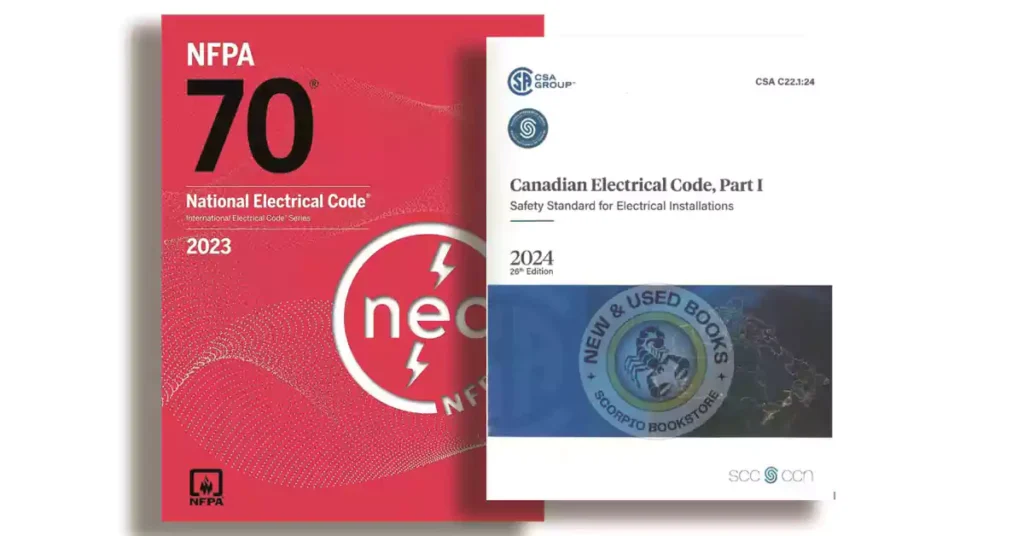
Navigating electrical installations across the United States and Canada requires a comprehensive understanding of both the 国家电气规范 (NEC) and the Canadian Electrical Code (CEC). While both codes aim to ensure safety and standardization, they exhibit distinct differences that professionals must recognize to ensure compliance in cross-border projects.
Overview of NEC and CEC
The National Electrical Code (NEC), developed by the National Fire Protection Association (NFPA), serves as the benchmark for safe electrical design, installation, and inspection in the United States. It undergoes revisions every three years to incorporate technological advancements and emerging safety concerns.
Conversely, the Canadian Electrical Code (CEC), published by the Canadian Standards Association (CSA), governs electrical installations in Canada. Similar to the NEC, the CEC is updated triennially, with its latest 26th edition released in March 2024.
8 Differences Between NEC and CEC
While both codes share foundational safety principles, several key differences exist:
Voltage and Frequency Standards
NEC: Standard residential voltage: 120/240V single-phase and 60Hz.
Three-phase systems: 208V, 240V, 480V.
CEC: Uses the same 120/240V and 60Hz standard
Three-phase systems: 120/208V, 347/600V (common in Canadian industrial settings).
Hazardous Location Classification
Both the NEC and CEC allow two classification methods for hazardous locations: Class and Division and Class and Zone. However, a key distinction is that the CEC mandates the use of the Class and Zone system for all new installations, while the NEC still permits the Class and Division system as an alternative. This shift in the CEC aligns with international IEC standards, improving compatibility with global electrical systems.
Circuit Breaker Limitation
The NEC restricts the number of overcurrent protection devices to a maximum of 42 within a single panelboard, aiming to prevent potential catastrophic failures due to sudden overload surges. The CEC, however, imposes no such limit, trusting that a properly installed system minimizes the risk of all breakers tripping simultaneously. This flexibility allows for more extensive electrical systems without additional panelboards in Canadian installations.
Ampacity Tables and Temperature Derating
NEC Approach: The NEC provides extensive ampacity tables, with separate sections for medium voltage and low voltage conductors. It also allows for temperature derating factors greater than 1 when ambient temperatures are cooler than reference values, enabling an increase in conductor ampacity.
CEC Approach: The CEC simplifies ampacity considerations by providing a single ampacity table for both low and medium voltage conductors above ground. However, it restricts temperature derating factors to a maximum of 1, meaning improvements in ampacity beyond CEC tables are not permitted.
接地和接合
NEC: Specifies standardized grounding methods and materials, emphasizing uniformity and safety.
CEC: Offers more flexibility in grounding methods, allowing adaptation to local practices as long as safety criteria are met. This flexibility can reduce installation costs and adapt to specific environmental conditions in Canada.
Conduit and Wiring Methods
NEC: Provides more options for conduit types and installation methods, including the use of flexible metal conduits in certain areas.
CEC: Places stricter requirements on conduit installations, especially in areas with high moisture or extreme temperatures, to ensure long-term durability and fire resistance.
Arc and Ground Fault Protection
NEC: Requires Arc Fault Circuit Interrupter (AFCI) protection for all bedroom circuits and certain living spaces.
CEC: Enforces similar requirements but extends AFCI protection to additional residential circuits, including kitchens and laundry rooms, for enhanced fire prevention.
Product Certification and Approval
NEC: Accepts equipment certified by UL (Underwriters Laboratories) or other nationally recognized testing laboratories.
CEC: Requires certification by CSA (Canadian Standards Association) or equivalent Canadian-recognized approval bodies.
Comparison Table: NEC vs. CEC
Comparison Table: NEC vs. CEC Code
方面 | NEC (USA) | CEC (Canada) |
Voltages & Frequency | 120/240V, 60Hz | 120/240V, 60Hz |
Hazardous Location | Class & Division or Class & Zone (optional) | Class &Zone (mandatory for new installations) |
Circuit Breaker Limit | Max 42 devices per panel board | No limit |
Ampacity | Separate for low and medium voltage | One table for both |
Temperature Derating | Greater than 1 allowed | Limited to 1 |
Grounding & Bonding | Standardized methods | Flexible methods |
电弧故障保护 | Bedrooms & some living spaces | Extended to kitchens and laundry rooms |
Product Certification | UL | 加拿大航空 |
Case Study: A U.S.-Canada Joint Venture Navigating Dual Compliance
A multinational data center project between a U.S. contractor and a Canadian electrical engineering firm faced challenges in meeting both NEC and CEC standards. The Canadian side required flexible grounding methods and stricter conduit installation for cold-weather environments, while the U.S. team focused on meeting NEC’s arc fault protection and circuit breaker limitations. By conducting pre-installation risk assessments, the teams successfully integrated CEC-compliant non-metallic conduits and NEC-standard AFCI devices, ensuring compliance with both codes and avoiding costly rework.
Practical Applications for Electrical Contractors & Manufacturers
A. Best Practices for Installation
1.Integrating Conduit Systems in Line with CEC Standards
- Use Approved Materials: Source wiring, conduits, and fittings that meet the CEC’s strict requirements to ensure compliance and enhance durability.
- Follow Updated Wiring Methods: Implement modern wiring techniques as outlined in the latest CEC edition to accommodate increased load demands and reduce fire hazards.
- Regular Training & Certification: Ensure technicians undergo continuous training and certification updates to stay informed about the latest CEC revisions.
- Documentation and Record Keeping: Maintain detailed documentation of all installations, permits, and inspection reports for regulatory compliance and future maintenance.
2. Importance of Using Approved Materials and Methods
- Certified Conduits and Fittings: Use CSA-certified rigid PVC conduits, EMT, or liquid-tight flexible conduits depending on the application.
- Proper Installation Techniques: Maintain appropriate clearances and secure conduit runs to prevent mechanical damage and corrosion.
- Regular Inspections and Testing: Conduct periodic testing for grounding resistance and insulation integrity.
B. Tools & Resources
1. Recommended Checklists and Guidelines
CEC Compliance Checklist for Electrical Installations
Conduit Sizing and Ampacity Calculation Tools
Grounding and Bonding Best Practice Guide
2.Downloadable Resources
Digital Checklists aligned with CEC standards
Mobile apps for quick reference to CEC guidelines
Online training courses from CSA and other accredited institutions
3. Online Platforms and Forums
Canadian Electrical Contractors Association (CECA)
Electrical Safety Authority (ESA) Resources
CEC Code Update Webinars
C. Real-World Examples
1. Case Study: Delta Conduit Manufacturing
Integrated the latest CEC guidelines into production processes.
Achieved a 15% reduction in installation errors.
Improved customer satisfaction due to enhanced product safety and durability.
“By aligning our manufacturing process with the latest CEC standards, we not only ensured safety but also gained a competitive edge in the market,” remarked Sarah Nguyen, Quality Assurance Manager at Delta Conduit Manufacturing.
2. Industrial Manufacturing Plant Upgrade
Upgraded electrical infrastructure using CSA-certified PVC conduit systems
Implemented flexible grounding methods to comply with CEC requirements.
Enhanced fire prevention with advanced AFCI protection.
3. Renewable Energy Solar Farm Project
Deployed heavy-duty corrugated conduits for underground cable routing.
Integrated proper bonding techniques for lightning protection.
Improved efficiency and safety with temperature-compliant ampacity calculations.
D. Video/Testimonial Section
Expert Interviews
Electrical engineers discussing successful CEC-compliant projects.
Insights from CSA certification experts on selecting approved materials.
Contractor Testimonials
Testimonials from contractors who achieved safety improvements and efficiency gains.
Demonstrations of proper conduit installation and grounding techniques.
Visual Demonstrations
Time-lapse footage of conduit system installations.
Safety inspections and testing procedures in action.
The Future of the CEC Code
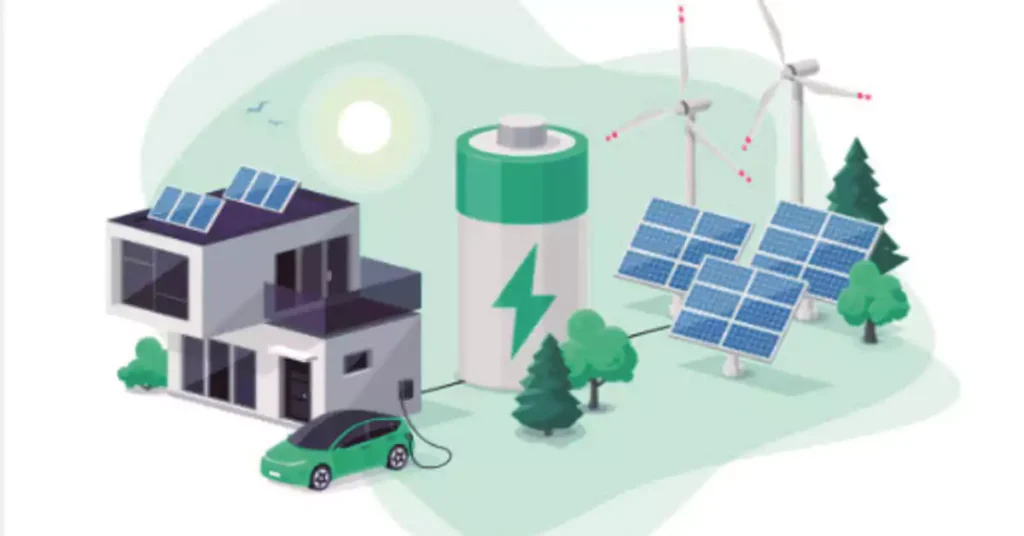
A. Product Design
Material Innovation: Development of flame-retardant conduits, low smoke halogen-free materials, and corrosion-resistant coatings to meet evolving CEC standards.
可持续解决方案: Incorporating eco-friendly and recyclable materials to align with green building initiatives.
Durability and Flexibility: Improved materials that withstand extreme temperatures and mechanical stress.
可持续解决方案: Eco-friendly materials that align with green building standards.
B. Testing & Certification
CSA/UL Certification Processes: Ensuring compliance with rigorous testing for fire resistance, mechanical strength, and electrical insulation.
Advanced Testing Facilities: Utilizing high-voltage labs to simulate extreme conditions for medium and high-voltage conduit systems.
Continuous Audits and Quality Control: Regular inspections and material traceability to meet CEC’s evolving safety requirements.
C. Marketing Edges
Enhanced Product Credibility: Showcasing CEC compliance in product documentation.
Customer Assurance: Building trust with contractors and end-users through verified safety standards.
Global Market Access: Meeting international standards for export opportunities.
D. Emerging Applications
EV Charging Infrastructure: Designing high-durability conduit systems for Level 2 and DC fast chargers that meet CEC’s strict grounding and bonding requirements.
人工智能数据中心: Implementing fire-resistant conduits and advanced cable management solutions to support high-power computing environments.
Smart Conduit Solutions: Integration of real-time monitoring and predictive maintenance capabilities.
How Ledes Provides Safety and Compliance Solutions
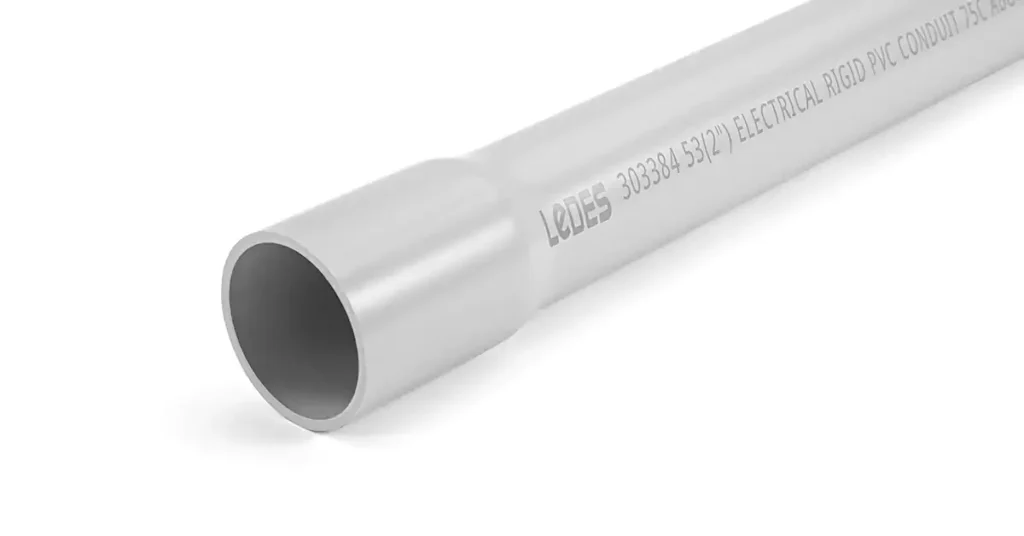
关于Ledes
Ledes is a global supplier of manufacturing electrical conduit systems and fittings that meet the highest safety and compliance standards. With a strong focus on innovation and quality, Ledes products are widely used across various industries, including renewable energy, data centers, and infrastructure projects. By adhering to both the Canadian Electrical Code (CEC) and the National Electrical Code (NEC), Ledes ensures optimal performance, durability, and safety in electrical installations.
Products that Compliant with CEC and NEC
CSA – approved rigid PVC conduit, DB2 rigid PVC conduit for direct burial applications, electrical non-metallic tubing, elbows and bends, couplings and other fittings.
UL – Listed Schedule 40 & 80 rigid PVC conduit, DB100, DB120 rigid PVC conduit, ENT, elbows, couplings, adapters, and electrical boxes such as slab boxes, wall boxes, gang boxes and conduit bodies etc.
Heavy duty and medium duty low smoke halogen free rigid conduit, corrugated conduit, fittings and electrical boxes.
Meet CEC and NEC fire safety standards.
Suitable for high-risk environments such as tunnels, transportation systems, and data centers.
Solar rigid PVC conduit, corrugated conduit, fittings and boxes.
Designed for high-voltage photovoltaic systems.
Meets both NEC grounding and bonding requirements and CEC flexibility standards.
Advantages of Ledes Products
CEC and NEC Dual Compliance: Ensuring compatibility for cross-border projects.
High Durability and Performance: Resistant to extreme temperatures, corrosion, and mechanical stress.
Advanced Fire Safety Features: LSZH materials minimize toxic emissions and prevent fire hazards.
Flexible Installation Solutions: Suitable for both aboveground and underground applications.
Sustainable and Eco-Friendly Materials: Supporting green energy initiatives and reducing carbon footprints.
Joint Projects
Metro Tunnel Project (Melbourne and Victoria, Australia)
The Metro Tunnel, formerly known as Melbourne Metro Rail (MMR), is an underground rapid transit project currently under construction in Melbourne, Victoria, Australia. The project involves the construction of twin 9-kilometre (5.6 mi) rail tunnels between South Kensington and South Yarra with five new underground stations. It aims to connect the Pakenham and Cranbourne lines with the Sunbury line, creating a new high-frequency cross-city line that bypasses Flinders Street station and the City Loop. The Metro Tunnel is equipped with high-capacity signaling and platform screen doors, a first for Melbourne.
Ledes’ Low Smoke Halogen-Free (LSZH) conduit and fittings were selected for this project to enhance fire safety and ensure durability in the challenging underground environment. These conduits provide superior protection against fire hazards and reduce toxic emissions, aligning with the project’s high safety standards.
CHPE Project (New York to Canada)
The Champlain Hudson Power Express (CHPE) is a high-voltage direct current (HVDC) underwater and underground power cable project linking Quebec to the New York City neighborhood of Astoria, Queens. Developed by Transmission Developers Inc. (TDI), a Blackstone Group portfolio company, the project aims to carry clean energy, including hydropower and wind power from eastern Canada, directly to the New York City electricity market. Construction began in 2022, with completion expected by 2026. The estimated total cost is $4.5 billion USD.
Ledes’ Schedule 40 PVC conduit and fittings were utilized in the CHPE project to protect electrical wiring and ensure long-term performance in the underground sections. The rigid PVC conduit’s durability, corrosion resistance, and compliance with NEC and CEC standards made it an ideal choice for this critical infrastructure project.
Customer Feedback
Electrical Contractors 1: “Ledes’ LSZH conduit systems significantly improved our project’s safety compliance and reduced installation time. Their products are fully certified for both Canadian and U.S. markets.”
Electrical Contractors 2: “We achieved seamless installation of solar conduits for our renewable energy project thanks to Ledes’ superior quality and compliance with CEC guidelines.”
结论
The Canadian Electrical Code (CEC) serves as a cornerstone for electrical safety and innovation in Canada. By establishing rigorous standards for electrical installations, the CEC ensures enhanced fire protection, system reliability, and energy efficiency across various sectors. From material specifications to testing and certification processes, the CEC plays a vital role in maintaining compliance and protecting lives and property. As industries evolve with the integration of electric vehicles and AI data centers, the CEC continues to adapt, driving technological advancements while prioritizing safety.
To further enhance your knowledge and compliance with the CEC, download the official CEC checklist or reach out to the Canadian Standards Association (CSA) for specialized training and certification programs.
Frequently Asked Questions (FAQs):
CEC 多久更新一次?
加拿大电气规范 (CEC) 每三年更新一次,以反映技术、安全标准和行业最佳实践的进步。最新版本是 2024 年由加拿大标准协会 (CSA) 发布的 26 版。
我的省份如何采用 CEC?
加拿大各省或地区均以各自的方式采用 CEC,通常会进行具体修订以符合当地的安全法规和环境条件。例如,不列颠哥伦比亚省执行的《不列颠哥伦比亚省电气规范》以 CEC 为基础,但由于该地区存在地震风险,因此增加了抗震安全规则。同样,魁北克省采用《魁北克建筑规范》,该规范将 CEC 标准与当地法语要求和区域电气实践相结合。
电气承包商如何确保合规?
Electrical contractors can ensure compliance with the Canadian Electrical Code (CEC) by following these steps:
- Stay Updated: Regularly review the latest version of the CEC and understand any provincial amendments.
- Obtain Proper Training: Complete CSA-certified training programs to fully understand CEC requirements.
- Use Certified Materials: Install only CEC-compliant electrical conduits, fittings, and components that meet safety standards.
- Conduct Regular Inspections: Perform thorough inspections during and after installation to ensure code compliance.
- Work with Licensed Electricians: Hire certified professionals who are familiar with the CEC and local regulations.
- Maintain Proper Documentation: Keep accurate records of installation procedures and inspection reports for future reference.
- Consult Local Authorities: Communicate with electrical inspectors or regulatory bodies for clarification on specific code requirements.


